September 16, 2013
If you run barefoot or in minimalist footwear (or want to), and you also ride a bicycle or are interested in getting into the sport of cycling, then today's post is for you.
See, in the article “How To Start Running Barefoot“, I present the myriad of benefits you get when you switch to minimalist running shoes or go “unshod” more often. The underlying concept is that you should simply to try to expose your feet to natural stress, rather than protect them with a constant bubble of built-up, protective footwear that leaves your foot ligaments, tendons and bones completely unable to function on their own.
It's just a more natural, ancestral way of treating your feet.
Problem is, when it comes to riding your bicycle, there can be a big trade-off between a minimalist approach and the amount of power you produce. This is because minimalist footwear simply isn't stiff enough to allow for an adequate power transfer from a foot to a pedal. That's why there's a stiff carbon sole on the bottom of the very best cycling shoes on the face of the planet – the cycling shoes used by professional cyclists and triathletes.
For example, when I hold the Skora running shoes in which I race Ironman triathlons and bend them, I can easily fold them in half with my hand. In a runner trained to run barefoot or minimalist, that type of freedom and flexibility works great – for running. If these shoes had a carbon sole like a typical good cycling shoe, I obviously wouldn't be able to do bend them like that.
So in the past, I've always worn a good, stiff cycling shoe with a carbon sole.
However, ever since I began two years ago to take a minimalist running approach, go barefoot more often, and avoid fancy, built-up running shoes, my feet have drastically changed. They've become more naturally shaped, they've become amazingly stronger and tougher, and they function and move differently. The feet actual undergo anatomical changes when you switch to minimalist footwear or barefoot running!
And this anatomical change has created a problem – a problem that you too may be experiencing if you A) run barefoot or in minimalist footwear and/or B) experience foot, knee, hip or back discomfort while cycling. The problem is that the change in the function and and anatomy of your feet will significantly affect the way your hips, knees and feet feel when you're riding a bike in a normal pair of cycling shoes.
And frankly, it's quite annoying.
My body simply can't seem to live happily with running barefoot and minimalist running, while simultaneously training in the average stiff, protective cycling shoe. I've tried wedges, shims and every other strategy you can see discussed in this LAVA Magazine article. The article points out the frustration, pain and subpar performance behind the myriad of issues faced by trying to get the average athlete's foot to fit properly into a shoe.
Many cyclists go years and years simply fighting the bike, fighting their feet, and fighting those pedals. They're simply never “comfortable” on a bike. This might describe you. It certainly describes me in the past two years.
So I've experimented quite a bit, unsuccessfully trying eight different brands of cycling shoes, including Specialized Body Geometry, Sidi, Louis Garneau and other fancy brands.
But unfornutately, there are “no rules” in designing performance cycling shoes. Most shoes are made with fashionable displays of colors and useless gadgets ablaze throughout the shoe, but the shoes are heavy with thick soles – making for a ridiculous, unnatural fit to the foot height and poor fitting toe box shapes. It seemed as though no shoe was focused on the ultimate combination of comfort and performance.
Material selection is another issue. Most cycling companies use a variety of nylon injected plastic for their bases, and many are now introducing a fiberglass/ carbon mixture for their higher-end shoes. However, the resin used is more “plastic” than “carbon” and the bases have to be sanded in mass in large tumblers, or sand-blasting rooms, then sprayed with clear-coat to retain any aesthetic value. The end result is a shoe base that is too thick and too stiff but has the “look” of a slick carbon sole. Then the cycling companies will top the shoes with materials that are targeted at fashion first, function second, resulting in poorly functioning “eye candy” shoes.
And I've also tried extremely “unconventional” approaches.
For example, I raced the Wildflower Half Ironman and Olympic distance triathlons this year in a pair of PyroPlatforms. These are literally platforms that attach to a regular set of cycling cleats, and then you wear your minimalist footwear or go barefoot on top of the platform. Here's what the PyroPlatform looks like:
This was a big mistake. These things broke repeatedly within two weeks of “normal” use, and snapped off during the transition of the Olympic distance triathlon, costing me nearly 5 minutes during the race. And they made the feet cramp as the toes curled in an attempt to “clutch” the platform. I'm sure it's a great group of folks that make the PyroPlatform, but they certainly didn't work as a viable minimalist cycling footwear approach for me.
In addition, I've attempted using cycling cages (non clip-on) pedals with my Skora minimalist shoes or with Vibrams. That works OK, but the power transfer is absolutely horrible, and no serious cyclist or triathlete who wants speed and efficiency would use this approach for anything except, say, commuting to the grocery store.
I've also read some very interesting comments on the Paleohacks forum, which tends to have an extremely ancestral approach to activity. Here are some of the more interesting anecdotes from that forum's thread about minimalist footwear for cycling:
“It looks like Teva had a flip-flop that was cleat-able. Here's an example with egg-beater cleats. You could get something like this, and maybe poke a few more holes in the sole to strap it to your foot a little more securely than just the flip-flop straps.
I'm also seeing a lot of stiff-looking leather sandals, such as here and here. Those looks stiff enough to bike in, but still zero-drop or close to it.
The problem with going too minimal, of course, is that the sole won't be thick enough for the cleat (I'm assuming you've got a cleat system, be it spd or egg-beaters) making walking on the other end difficult. There are some other less minimal options that still give your toes some air.
I've been thinking about this a lot lately, too. I have been walking for my commute, but I'm racking up too many miles and my plantar fasciitis has come back. I'd like to start biking again, but my toes no longer fit in my old bike shoes, and my high arches don't have enough thickness to comfortably sit on top of the cleat. So thanks for this question, because it's reminding me I need to get new sandals to put my cleats on.”
and
“Assuming you don't have clip in pedals. I don't either. I've used Chrome bike messenger shoes for a couple years now. They have nylon reinforced soles to transfer power to the pedal and they look pretty cool, too.”
and
“I'm not surprised that biking in Vibram Five Finger's can cause plantar fasciitis–much of the energy from your legs is spent deforming your foot instead of moving the pedals. In cycling shoes, stiffer means more comfortable as well as more efficient.
I would ask you to consider a high tech maximalist approach to cycling footwear. Modern road cycling shoes are stiff, lightweight, and well-ventilated. The retail prices are admittedly expensive, but you can watch for specials and closeouts at sites such as Bike Nashbar and Performance Bicycle. As others have mentioned, Keen and Shimano have open-toed options that accept mountain bike cleats.
The main drawback to cycling shoes is that they're not made for walking, especially road shoes. “Rideability” and “walkability” tend to be inversely related.”
So you're probably getting the idea at this point: if you want minimalist cycling footwear you better be ready to sacrifice comfort, sacrifice speed, or sacrifice both.
————————————————–
A Solution For The Ultimate Combination of Foot Comfort And Speed While Cycling
So a few weeks ago, I had a final, desperate, last resort idea.
I read in a triathlon magazine about a company called “Rocket7“, which actually molds your foot with a custom casting that they send to your house, then creates a cycling shoe that is just as stiff as the nicest shoe out there, but is also 100% formed to your specific foot shape. They're actually designed for cyclists who deal with annoying issues such as numb feet, dying toes, bunions, stress fractures, nerve pain, back pain, knee pain and plantar fascitiis – but I immediately saw the value for a minimalist runner in actually having a cycling shoe that fits like a glove around the exact anatomy of the feet.
So I called the owner, KC, on the phone (he happens to be a US Olympic cycling champion), and explained that I was interested in trialing the shoes and letting my blog readers know about what goes into the process of fixing your feet with custom, prescription cycling shoes. He was game, and within a week, a box arrived at my house with:
-A foot sizer to determine the exact width and length, to the millimeter, of both my left and right foot…
-A crush foam impression box to get a custom mold of both my feet…
-A liquid cast to wrap around each foot and create a hard cast of each foot…
-All extra equipment I needed to do the casting process, like tape, scissors, a plastic footie bag, and gloves…
-A special form that that allows you to select finer details, such as colors, custom cleat placement holes, straps, cycling vs. triathlon shoes, etc.
It was all spelled out in the instructions that came in the box. Here's how the process went:
So first, I measured each foot and did the foam crushing mold…
Next, with the help of my wife, I casted each foot (it takes about 10 minutes per foot)…
Next, I cut off the casts and…Voila! A perfect mold of my foot…
Then I simply put all this in a box with a return label to Rocket7, and waited for the magic to happen.
A couple weeks later, here's what arrived at my doorstep.
I must admit that I was really drooling when I got my hands on these bad boys, especially when I saw the custom name stitching “B Greenfield” on the side, and the red, black and white colors to perfectly match my Team Timex racing uniform.
But the real magic happened when I threw my old cleats on and hopped on my triathlon bike for a spin down the trail.
I was literally blown away.
For the first time in my life, I truly felt like my cycling shoes were 100% compatible with the shape of my foot, I felt a completely seamless power transfer from my foot to the pedal, and the old, aching fight in my feet, my knees, my hips and my back was literally gone. Just like that.
My bike felt natural again.
———————————
Summary
For me, this turned out to be the ultimate solution – and my feet, knees, hips and back are happy once again. I was shocked at how much of a difference something as “simple” as a shoe could make, and I can't wait to rock these Rocket7's during Ironman World Championships in Kona, Hawaii this year.
Now I do indeed realize that custom cycling shoes are spendy, but these really are one of the nicest pieces of cycling equipment you're ever going to own – and you're in this sport for the long haul, this would be one of the smartest investments you could make.
You get what you pay for, too.
Rocket7 uses the highest quality materials possible, with 3K tow carbon fiber and extremely high quality epoxy resins money. They integrate a very cool shock dampening system into each shoe that allows additional carbon fiber to stiffen up the shoe while keeping it extremely comfortable for the longer rides. As you can see from the photo of my shoes above, the upper part of the shoe is hand stitched using the finest micro-fibers – and they don’t mess around with high-fashion graphics or useless design.
In addition, no cycling shoe in the world is as light, lending even more to the “minimalist”, molded feel of these shoes. Of course, this is also important from a performance standpoint, since the shoe is a component of rotating mass. Rotating mass increases exponentially as your cycling cadence increases – so the heavier the cycling shoe, the harder your leg and foot muscles are going to have to work to maintain any given speed.
I wouldn't be writing this article unless I were thoroughly impressed with the fit, the look and the design of this shoe – and suddenly for me, cycling has once again become a 100% enjoyable experience, with absolutely no feeling of fighting the bike or fighting the pedals. It feels like…cycling barefoot – in a good way.
So if you are a minimalist runner who wants minimalist cycling shoes…
…or if you have wide or narrow feet, struggle with foot, knee, back or hip pain while cycling, or simply want a “one of a kind” custom shoe that you can put your name on, I'd recommend you consider adding these to your wishlist, your Christmas list, your birthday list, or just getting them now.
Full disclosure: I make no money if you buy these shoes, but I did receive a complementary pair of Rocket7's to trial. And I'd gladly pay for them.
Clarification: You don't have to get full custom prescription shoes from Rocket7. They also have stock shoes, and modified stock shoes. You'll find it all spelled out on the Rocket7 website.
Questions, comments or feedback about minimalist cycling shoes, custom cycling footwear, or the Rocket 7's? Leave your thoughts below!


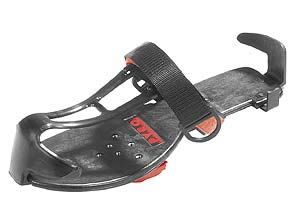
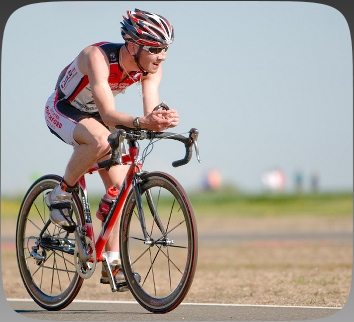


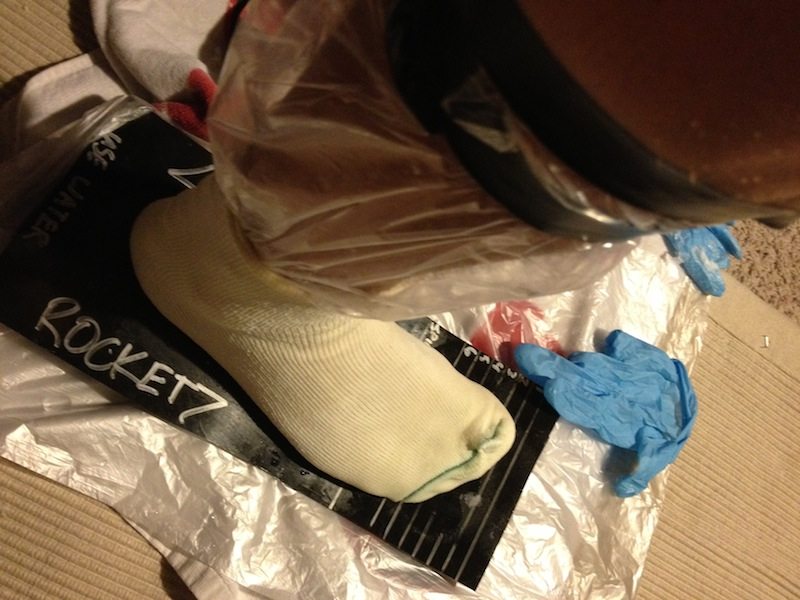

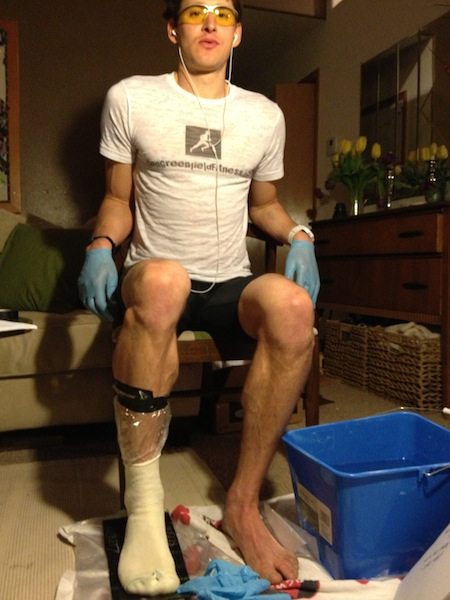

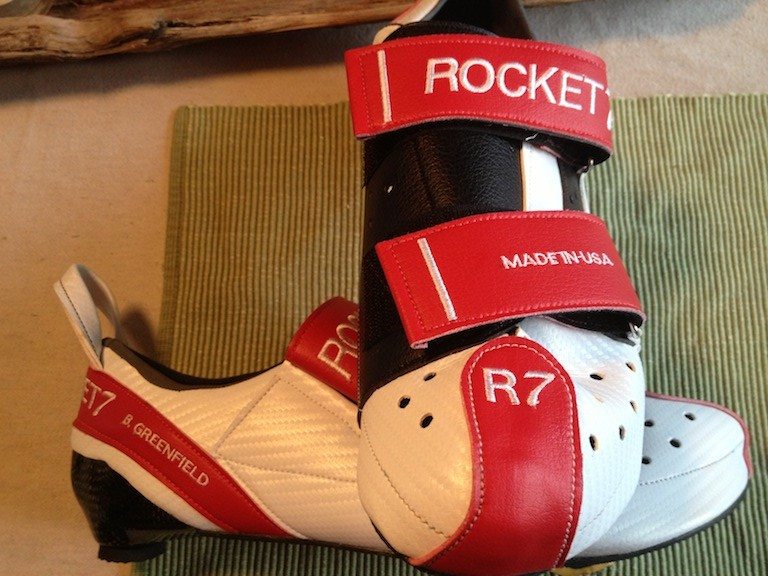

Two questions:
1) The tops of the shoes look like they might be flexible. Is that right?
2) Do you think there would be any advantage in have a cycling shoe with a sole that was stiff only under the forefoot?
Hi Ben! Do you still cycle with these shoes? I see this post is a few years old and was curious if you have found a cycling shoe your prefer over the ones mentioned here.
Thanks!
I would recommend checking out Catalyst pedals from Pedaling Innovations. https://pedalinginnovations.com/
I have been experiencing Achilles Tendonosis and Plantar Fasciitis for nearly two years due to bad running shoes, running on concrete, heel striking, and over training (running). Long story short: transitioning to minimalist shoes, correcting my toe shape, and physical therapy are part of my treatment, and its working. However, I bike commute and as you know, biking shoes are about as opposite to minimal and natural shaped shoes as you can get. I need a wide toe box and flexible sole. However, cycling traditional pedals in shoes with a flexible sole put too much strain on my plantar fascia and achilles for me to heal properly. The Catalyst pedals worked because there is no foot flex or strain to the plantar fascia. Your foot stays flat, and most of the work is pushing with your hips. You end up being less dependent on your calf muscles, so much less strain to my achilles. I can wear any shoes with them, even my flexible Lems or Xeros with wide toe boxes. The pedals aren’t perfect, a bit heavy, and if your toe is too far off the front it will hit your front tire or fender, but I have big feet. They’ve been a huge help for me being able to bike commute while treating these ailments.
How do your Xero and Lems hold up to the pins in the pedals? I ride Catalyst on my fatbike and am going to ride them on my gravel bike.
So I’ve recently switched to barefoot shoes. I’ve started riding my plain old mountain bike lately and have noticed that my plantar fasciitis has been acting up. Do you think rocket 7 mountain bike shoes would be helpful for me? Also would these shoes work with regular plain mountain bike pedals?
I do think it could help. Rocket 7 makes a mt bike specific shoe too that will work with your pedals.
Hey Ben,
So are you still able to go barefoot/minimalist (as in, still reap the rewards of barefoot/minimalist training) whilst in the Rocket 7s?
If so, would it be possible for them to make footy boots like that (australian rules football)?
I’m currently gong barefoot, and yet to see any big anatomical changes like you talked about, but there’s no way I’ll ever play footy without shoes – I can’t kick the ball in barefeet, and of course, if I got stood on, it might hurt a lil bit.
SOOOOOO – do you think it would be possible for me to still get the benefits of barefoot training, with a pair of customised Rocket 7s for the douglet?? (in red and black, of course)
Yep absolutely…it's like barefoot training for cyclists!
Real brill read i wear i pair of vibram 10 finger running shoes and ride a 2013 Spech full x this morning I just wondered if any one else rides this way. Some times a nice pair of strong boots are ideal for trails but for gentle a still think barefoot is fun!
Now that I’ve begun club riding, I’ve been searching for cycling compatible minimalist shoes. I’ve previously shied away from cleat compatible shoes because I didn’t have a need for their benefits. Currently I ride with a pair of old Merrell Trail Gloves fitted into half-toe clips attached to full-width pedals to fully support the forefoot. Due to their excessive flex I tighten the shoes considerably more than I would for running to decrease sole flex, but sadly that inhibits building foot strength while cycling.
Your outcome is disappointing in that it doesn’t address foot strengthening and natural foot movement, but rather a shoe that fits your anatomically changed foot shape and sole stiffness that supports maximum power transfer and presumably arch support, both of which are the antithesis of the minimal footwear.
What I hoped your resolution would be was a solution that had a less flexible sole to faciliate power transfer, but still lacked other supportive features also not found on minimalist running shoes. You’ve just molded a comprehensive support structure to your newly shaped feet…how is that minimalist? I suppose I misinterpreted that this article would be about minimalist style cycling shoes rather than cycling shoes compatible with feet strengthened by minimalist running.
I still don’t feel a true need for cleat compatible shoes for myself, and will likely to upgrade to a stiffer-soled minimalist running shoe like the Skora’s 11mm(?) stack height. I can see the benefits of supportive cycling shoes for racing, but when training why not continue to strengthen your feet?
Pardon the grammatical errors in my earlier post, “cut-and-paste” on my smart phone led to poor proofreading.
These force me to use my feet far more than a normal cycling shoe, even though I'd agree that they aren't "perfectly" minimalist per se. But they're very close. I would try them. You'll see what I mean.
Skora look cool. I've recently moved to Inov8 and will move to their bare foot shoe in the next few weeks.
Interesting to see the pedal platform, haven't seen those since the 1990's. They appeared in the Powerman Duathlon series for a brief time, but the pro's switched back quickly as they never really worked.
Rocket7, on the wish list of stuff. Jonathan Vaughters was a huge fan from memory http://www.cyclingnews.com/blogs/jonathan-vaughte…
these look very interesting.. I'm more into running, so am going to look and see if they do custom running shoes.. when I first started reading, I was going to say that you should perhaps just stick to one type of running, barefoot or with shoes, but then I read the rest of the article.. ahem..
thanks for the article
For minimalist running you really can't beat http://skorarunning.com/who/ambassadors/ben-green…
…ok, a continuation:
So, to begin to summarize, regardless of individual variation in bone structure from one person to another, strength and activation of the muscles of the foot do play a critical role in supporting the joints and contribute to proper function all of the way up the chain, BUT….. a forefoot varus deformity for example, still places undue loads on the lateral portions of the foot and encourages valgus knee collapse with excessive medial rotation of the lower extremity. Think of it this way: a car with a poorly aligned front end can have a new suspension, strong springs, and the world’s best shocks, but it will still wear out the tires unevenly and eventually destroy parts further up the chain. In other words, a runner with excessive forefoot varus (who also happened to be unstable or weak in the core or hip girdle) would NOT be served by wearing a minimalist shoe and could end up doing significant damage to the knee, not to mention be at high risk for ITB syndrome or any of a variety of running related injuries. All of this would be exacerbated if she/he ALSO had limited dorsi-flexion of the ankle (quite common among many recreational and serious runners, and a recipe for injury related disaster for anyone running in a minimalist shoe.)
Based on available research as well as the hundreds of gait and movement analyses we’ve done at Pursuit Athletic Performance (http://Pursuit-Athletics-Performance.com), we estimate that approximately 20% of athletes are ideal candidates for minimalist shoes. In other cases, biomechanical problems in the foot (like over-pronation) or limited dorsi-flexion, were exacerbated by minimalist shoes, particularly Newtons (because, among other things, they place the foot in an even more extreme plantar flexed position during mid-stance).
As I said earlier, all of our athletes are given foot strengthening exercises, especially those for whom we prescribe orthotics. And yes, virtually everyone who has worn shoes for all or most of their life needs to strengthen their feet. However, it is worth noting that the intrinsic muscles of the feet do not automatically begin to work effectively and authentically simply by removing shoes. If this were the case, no one would need to learn how to create core stability or relearn any other authentic motor pattern once it was lost or had changed. Compensation, unfortunately for the athlete who is seeking superior performance and durability, is somewhat “normal” for the human body, and in fact, its amazingly effective at allowing those with TBI or similar, to function. But in athletes, it isn’t ideal or acceptable. We need to relearn – reactivate “authentic” patterns, including reactivating and strengthening those intrinsic muscles, and then groove that new groove with repetition and thoughtful “practice.” (Like any other activity). Combined with appropriate and progressive amounts of barefooted walking, the feet can begin working properly and be more ready to handle additional load. THE primary issue with running is that it is a LOT more stressful for the human body than folks tend to want to acknowledge. After all, a mile of running is ~1500 one-leg squat jumps, done against the forces of gravity and ground reaction (to the tune of 3-4x body weight!). Little issues become major ones, as the miles add up!
The bottom line: 1. The shape of the bones and the activation/strength of the foot muscles each contribute to foot mechanics. Both must be considered in training and treatment, and ignoring one usually contributes to injury of the other. 2. For this reason, there is a shoe (or lack thereof) that is appropriate for every single runner out there. Some do well in a minimalist shoe (neutral foot mechanics and solid posture/functional stability/strength), but for others, going to a minimalist shoe for RUNNING in particular, can be a recipe for disaster (from an injury risk POV). Anyway Ben, I appreciate you responding back to me and giving me an opportunity to respond. You're one smart guy and an inquisitive learner, obviously. I hope some of this has been helpful in clarifying where I was coming from.
I'm looking forward to our discussion on this topic when you join me on OUR podcast in October. Should be great. In the interim, good luck with Kona prep!
All my best, Al
Hi Ben,
Thanks for posting. For the record, I am a fan of Rocket 7. I've had a pair for quite a few years, with my name stitched right into the shoe. Pretty cool.
As I mentioned to you in an email, I disagree completely with one comment you made in this article. I also appreciate your responding to my email on it, and then your willingness to join me and my partner, Dr. Kurt Strecker, in discussing this topic on our Pursuit Athletic Performance podcast in October. Looking forward to it! You suggested I post my reply to your inquiry here on your blog, so that's what I am doing. :)
So what statement did I have an issue with? The statement you made here: "there are a ton of benefits you get when you switch to minimalist running shoes"…..
Allow me to share some thoughts as to why this comment struck me and why its my opinion (and the opinion of the science regarding how our feet and body function) that its flat out wrong for every person. Please know it is all conveyed with the utmost respect for you as a coach, author, expert. You are obviously a very smart guy and accomplished athlete who is setting the bar in many areas in our sport.
So, yes Ben, while SOME runners might achieve benefits if they switch to a minimalist shoe, only a certain percentage of people who run are actually candidates for a minimalist type of shoe. Many are not. Yes, this goes against the wisdom conveyed by the marketing geniuses at all of the running shoe companies….but who said we should just blindly believe the marketing hype, without actually knowing the facts?
And yes, to your point, there is no question that shoes (and orthotics) reduce the activity of the intrinsic, and to some degree extrinsic, foot muscles, in effect "weakening" our feet. (All of our athletes are given foot strengthening exercises, especially those for whom we prescribe orthotics).
However, that being said, the amount of "benefits" any individual person might achieve from switching to a minimalist shoe is dependent upon many factors, including not only their age and athletic history (what about the middle age man who has spent the majority of his adult life sitting on the couch, vs. a teenage female soccer/lacrosse player) but most especially their individual foot mechanics, e.g. the shape of the bones of the feet. That is, the biomechanics of the foot are governed by the shape of the bones and the activation of the muscles. We ALL have feet which are unique, with unique foot mechanics.
It is critical to note that the biomechanics of the foot largely dictate the movement of the tibia/fibula, while the stability and strength of the "core" (trunk) and hips primarily govern the movement of the femur. The sum total produces the mechanics of the knee. Why is this so important? Shoe choice for something as dynamic as running, ends up having a very dramatic impact on the health of our knees.
To put it a little differently or see it another way, individual variation in the shape of the foot (i.e. the unique orientation of the talocrural joint, the oblique midtarsal joint axis, the longitudinal midtarsal joint axis, etc) produces significantly different loading of the foot and therefore alters function. This can be readily seen by simply observing callus patterns on the plantar surface, something we examine with each athlete we see as part of our analysis.
**(Continue on to the next post for a continuation of this response)
Great article but what is the cost of a customized biking shoe and what is the difference between already customized shoes to ones that use your molding. I have custom orthodonics with a heel lift on the right foot, should I use it in these shoes or not? I did not see pricing for the customized shoe but did see cost for repairs.
I'm going to have KC at Rocket7 get back to you on this one…